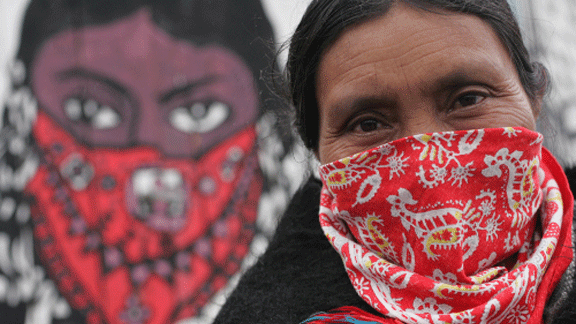The Zapatista festival of resistance

The Festival of Rebellion and Resistance Against Capitalism made its way through Mexico in December 2014 and January 2015. The festival was organised by the Zapatista Army of National Liberation (EZLN) and the National Indigenous Congress (CNI), a federation of indigenous communities in resistance from around the country.
The event provided useful insights into the ravages of capitalism in Mexico and the current state of the Zapatista movement and the indigenous struggle.
Most of the nearly 3,000 registered participants were indigenous activists, representing more than 20 indigenous language groups. There were many non-indigenous activists from organisations and collectives affiliated to the “Other Campaign”, which the EZLN initiated in opposition to the presidential election of 2006. The event also attracted more than 400 international guests, mainly from the Americas and Europe.
Perhaps the most important guests were a group of campesinos (small farmers and rural workers) and students from the state of Guerrero. They are parents, siblings and surviving classmates of 43 students from the rural teacher-training college at Ayotzinapa, who were forcibly disappeared (i.e. kidnapped by government forces and allegedly handed over to a drug cartel) for their organised opposition to the government’s neoliberal education “reforms” and their struggle against the conditions of extreme poverty and neglect they live and work under.
The issue of the 43 students has provoked outrage in Mexican society, as it demonstrated the links between all levels of government, all the major political parties and organised crime in the bloody repression of social movements.
We joined the festival for its last two legs, both in Chiapas. First was the New Year fiesta in the town of Oventik, in an area of Zapatista self-government. Oventik is an impressive place, as it has been built by the community.
In addition to shops and dwellings, there are a school, sport facilities, a church and a building dedicated to the organisation of women. Almost all the buildings are adorned with murals depicting dignified and happy masked Zapatista men, women and children, as well as revolutionary heroes from Emiliano Zapata to Che Guevara.
At roughly 11pm, more than 1,000 people gathered around a stage and watched as 43 empty chairs were set out. The families of the missing students were then welcomed. They held pictures of their missing sons, as we chanted “No están solos!” / “You are not alone!” Two of the parents gave speeches.
We had heard parents of the Ayotzinapa students speak twice before in Mexico City. Always they apologised for not being “orators”, for being “just” campesinos. In truth, these parents have become key orators and leaders of the struggle in Mexico.
Their fierce determination to speak out has kept the issue alive and has rallied large numbers to their cause for more than six months now.
The Ayotzinapa families also attended the conference sessions that began three days later at CIDECI-Unitierra, the University of the Earth, a Zapatista-built and run campus on the outskirts of San Cristobal.
The first day of the two-day event comprised reports from all of the previous sessions that had occurred in different states as well as new contributions by people telling of the problems that capitalism is causing in their local area. The two main themes that emerged were dispossession and repression.
Much of the dispossession related to “mega-projects”: dams, mines, highways, airports. One of the most obscene examples is the proposed Parque de las Siete Culturas, the Seven Cultures Theme Park in Puebla, whose investors will profit from selling knowledge about indigenous cultures. To make way for this development, the indigenous people are being displaced from their land – but not without resistance. Their representative stated that they “refuse to be turned into cultural merchandise”.
As for repression, we learned that Ayotzinapa is representative of a broader pattern in Mexico. Virtually every community in resistance spoke of the political prisoners taken from their struggle. Many also could talk of their disappeared or slain. Ever harsher anti-protest laws are being enacted. Bravery underlies all of the examples of radical activism in Mexico.
The final day involved the proposals session. Everyone was free to make proposals for action, and more than 100 speakers did. But these proposals were not discussed and debated, fleshed out, amended, adopted or rejected. They were simply stated, then added to the more than 400 pages of minutes.
While the event allowed for a sharing of stories, some participants expressed that their communities had raised money to send them there, and when they got back would want to know what courses of action had been decided.
The event was not structured to allow these decisions to be made. It appears that decision making – other than for local matters – is confined to the CNI leadership, which has a representative structure, and to the EZLN, which has an essentially military structure.
The Zapatistas and the larger networks of indigenous resistance in Mexico have maintained themselves impressively over the last 21 years. Numerous and varied mass struggles have continued to emerge, the most recent surrounding the 43 students. They have not yet achieved justice, but the government’s attempts to silence them have certainly failed.